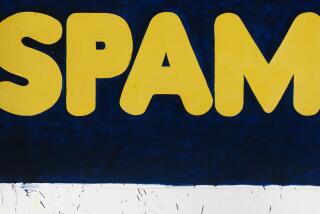Drawing on Memories of Early Years : Art: John Outterbridge’s exhibit at the Rancho Santiago College gallery not only bespeaks his past but also reflects his current beliefs and passions.
SANTA ANA — Growing up in North Carolina, John Outterbridge spent hours watching his white-haired grandmother, bent over on hands and knees, scrubbing floors.
“We were very, very poor,” recalls Outterbridge, now an artist living in Los Angeles. “But you never knew it. She made by hand the bars of soap she used, and she’d clean those floors until they were bone white. Many of the textures and tones I use today I recall from that period.”
Many memories and experiences have influenced Outterbridge, whose powerful art not only bespeaks his past like an assiduously assembled scrapbook, but simultaneously reflects his current beliefs and passions.
His childhood in the segregated South, his urban Chicago days, his political views, his beloved family, his African heritage, his fondness for society’s castoffs--it’s all there, as he tells it, in the works he’s made from bits of cloth, scrap metal, wooden beads or natty human hair.
A new exhibit at the Rancho Santiago College Art Gallery (through April 2) consists of 16 three-dimensional pieces by Outterbridge, who since 1976 has been director of the Watts Towers Arts Center, a community facility at the base of Sabato (Sam) Rodia’s soaring spires.
“Art: African American--The Southern California Experience” spans from the late 1960s to 1990. It includes the fetish-like “dolls” for which Outterbridge is best known, an homage to Dr. Martin Luther King Jr., and shiny or rusted steel “cars” that relate to Outterbridge’s L.A. lifestyle.
Outterbridge, 59, attended an agricultural and technical college in Greensboro, N.C., and served in the military during the Korean War before moving to Los Angeles from Chicago in 1963. He was exposed to creativity long before all that, however.
“My mother was the first poet I knew,” he said during an interview at the Rancho Santiago gallery. “She took in washing from rich white families and I remember helping her haul water for the laundry, but she wrote poetry and played the piano and she drew some. And my uncles and cousins were musicians, so I always had someone creative around. I don’t remember when I started to (make art), but it was just the way my environment was.”
Years later, in Chicago, where he worked for the city’s public transportation system, Outterbridge became fascinated by fabric scraps and rags--now one of his trademarks. “I’d always see the ragmen, who collected rags for a living,” he said. “They’d go around, calling up to people in apartment buildings for rags, and they could send their kids to college on what they made. Rags became something I always wanted to use.”
He added that castoff materials, sometimes stained or faded, have enabled him to represent “this other aesthetic,” one related to urbanization. “Alameda (Street, one of L.A.’s oldest) is a very favorite for me because it speaks about industrial America--how desperate that is and abusive and disrespectful of the environment, yet fabulous in a way, with its own texture and aesthetic.”
Bits of rusted metal and worn-out wooden wheels, fashioned into “Crack in the Road” (1990), a bread-box size, broken-down automobile, symbolize the unequivocally destructive aspects of urban life, he said. Meanwhile, the cargo on the auto’s roof--wooden beams in the shape of a cross--has political connotations.
“Sometimes you think the political process for many is a kind of religion. The science of racism is certainly a kind of religion.”
A longtime social activist who was involved in the civil rights movement of the 1950s, Outterbridge was affected profoundly by the King assassination (which took place on Outterbridge’s wife’s birthday). In 1975, he created “About Martin,” a chilling assemblage made up of a jacket and slacks hanging above a laundry receipt made out to King, stamped with the words Paid in Full.
Outterbridge addresses various social concerns, personal issues and other subjects with his dolls, stitched together from rags or other materials. He made his first doll long ago, not as art but as a toy for his daughter, now 25.
Through research, he “discovered that at one point, dolls were not considered toys but, in indigenous cultures, as personifications of the culture and its rituals, its worth, its color. I liked that and decided to do an Ethnic Heritage series with dolls.”
One of the series, “Captive Image,” a piece about slavery, consists of several black dolls chained to a cart that is painted in colors as vibrant as the clothes the dolls wear. The colors represent the strength in struggle, and an internal beauty that transcended the horror of the time, Outterbridge said.
“When you speak of that period, it’s hard to read through the issues to get to the color. But humanity always has color. These are the things you reach for, these are the things you attempt to touch.”
“Art: African American--The Southern California Experience,” works by John Outterbridge, continues through April 2 at the Rancho Santiago College Art Gallery, 1530 W. 17th St., Santa Ana. Hours: 10 a.m. to 2 p.m. Mondays through Thursdays; 6:30 to 8:30 p.m. Tuesdays and Wednesdays; 11 a.m. to 1 p.m. Fridays. Admission: free. Information: (714) 564-5614.
More to Read
The biggest entertainment stories
Get our big stories about Hollywood, film, television, music, arts, culture and more right in your inbox as soon as they publish.
You may occasionally receive promotional content from the Los Angeles Times.










